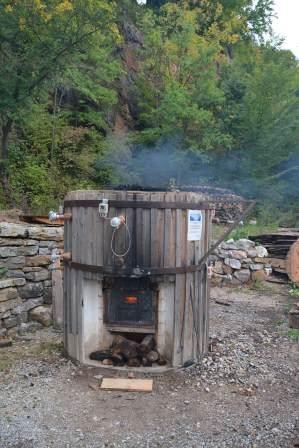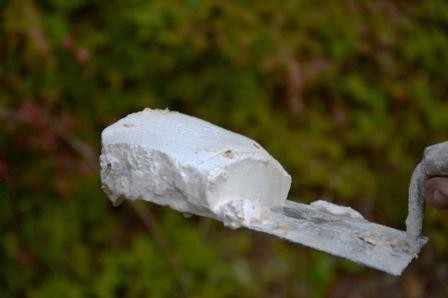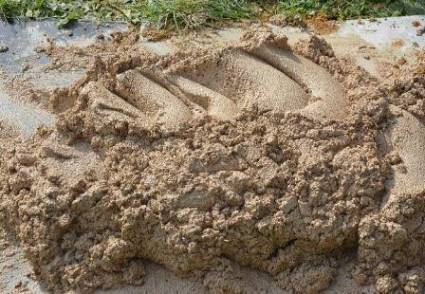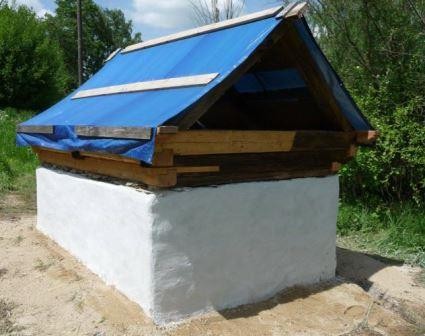Solvayovy Quarry - Experimental Lime Kiln
Research
- Study of historical construction materials (analyses, tests, consultations, case studies)
- Research on and replication of historical construction technologies
- Development and design of new mortar mixtures with a composition, quality and production process corresponding to the original historical compound
- Design of repair procedures for authentic elements of historical buildings in cases where the repair is carried out in such a manner that the resulting copy is as authentic as possible
- Documentation of sources of historical raw materials and technologies
- Identification of the origin of raw materials for lime or building stone (marble) production
- Material research (optimization of production and functional properties, setting and hardening processes)
- Evaluation of production factors, functional properties and environmental impacts
Research equipment
Lime kiln
The experimental lime kiln is designed for burning lime in the traditional way using wood and burning lime mixed with fuel. Typically, the kiln is operated in single charge mode, i.e. the charge is burnt and unloaded after loading; nevertheless, in case of mixed loading, the fuel and lime charges can be added and removed through the lower hole during the burning process. The single charge production of lime amounts to approx. 500 kg (CaO). The kiln is fitted with a temperature monitoring system around the shaft perimeter and with a flue gas analytical system (CO2, CO, O2). The operation and experimental use are described in publications [1, 2, 3, 4]. The lime kiln is a functional sample for project NAKI DF11P01OVV010.
Specifications:
- Maximum single charge: 1 ton of stone
- Fuel consumption: 600 kg wood per 500 kg CaO
- Maximum temperatures: 800-1200 °C
Burning modes:
- Single-charge burning using wood (mixed hardwood/softwood)
- Single-charge burning of fuel/limestone mixture (f 50-80); fuel: pressed wooden briquettes or wood-coal


The functional sample consists of non-hydraulic lime binder in the form of lime slurry. Its benefits include a set of properties, which are determined by the quality of the initial raw material, burning method, extinguishing in excess water and maturing. The use of lime slurry is associated with well-proven traditional procedures, which warrant the resulting quality. Recently, new key properties and process influences have been defined, which were laboratory tested and now allow quality control of the traditionally produced product [1, 5, 6]. The ability to imitate the historical original is a both unique and economically significant feature of this model product.

Traditional naturally hydrated lime (functional sample)
As the functional sample, naturally hydrated lime binder is used. It is suitable for use in civil engineering and especially for repairing historical buildings. The naturally hydrated lime was produced experimentally using dvorecko-prokopské limestone. Its unique and, at the same time, economically significant feature is its ability to imitate the original (similar initial material). The key properties and quality of the lime binder were re-validated in the laboratory with regard to traditional production and processing technologies [1, 7].Hot lime mortar (functional sample)
As the functional sample, hot lime mortar is used, produced by lime slaking directly in a sand/water mixture. It is characterized by the ability to closely imitate the historical original, maintaining its composition and preparation process, which is essential to the guarantee of its specific properties [1]. The hot lime mortar is prepared using a procedure which involves mixing unslaked lime with damp or wet sand. The lime slaking process may take place - depending on the method of processing - at different time intervals; what is essential is that it starts at the moment the lime is mixed with the sand. Naturally hydrated lime processed as hot mortar was used to renovate the protected cooling chamber in Salajna, see fig. 6.


The Calcarius maps and databases are available on the website www.calcarius.cz/gis.
The map of historical and current sources of raw materials for lime technologies shows the documented quarries and material sources from the 12th century until the present. The main attribute of the map is the indication of dates of the utilization of mineral deposits in terms of the start of mining works, time of operation, end of mining works and when the sites were left. This information is collected from archive sources, literature, and inventory and mapping geological studies, which describe the given sources of raw materials. The accuracy and completeness of the map is dependent on the quality and accuracy of the information available; generally speaking, both parameters decrease with an increase in the distance in time from the 20th century.
The map of carbonate raw materials for lime production gives a more detailed visualization of locations based on the chemical composition, age and lithological description of the stone material. The main attribute of the map, therefore, is the ability to distinguish the quarries and sources of raw materials by the geological designation of limestone and its composition. Chemical compositions are expressed as the average of analyses presented in published or archived studies. In specific cases, the chemical composition is complemented by findings collected through proprietary sampling and individual analyses. The geological composition is described and completed based on regional knowledge. The map characterizes the purity level of the raw material using the cementation index. The accuracy and completeness of the map is dependent on the availability of information sources.
The map of lime technologies allows the visualization of the locations of historical kilns, bowls, carbs, charcoal piles and other lime facilities, starting with archaeological findings from the ancient and early medieval times up until the industrial and technical monuments of the 20th century. Apart from technological descriptions, the main attribute, again, is the dates. The information used to determine the locations and technology descriptions included information from literature and written sources, the Archaeological Database of Bohemia, historical map works, our own field findings and information from regional museums, archives and websites focused on historical and technical monuments. The descriptions of archaeological findings from Moravia were taken from published written sources.




